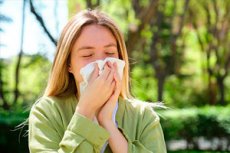New publications
Allergy shots are effective regardless of dose or severity of reaction
Last reviewed: 03.08.2025

All iLive content is medically reviewed or fact checked to ensure as much factual accuracy as possible.
We have strict sourcing guidelines and only link to reputable media sites, academic research institutions and, whenever possible, medically peer reviewed studies. Note that the numbers in parentheses ([1], [2], etc.) are clickable links to these studies.
If you feel that any of our content is inaccurate, out-of-date, or otherwise questionable, please select it and press Ctrl + Enter.

Each year, about 2.6 million Americans receive allergen-specific immunotherapy, commonly called “allergy shots.” These treatments have been available for decades and are generally safe and effective.
What's amazing is that scientists still don't fully understand how exactly these shots work. We know that the therapy contains small amounts of the allergen. And we know that this exposure to the allergen desensitizes immune cells and helps prevent allergic reactions.
However, scientists don't know how different doses of the allergen might affect different patients - and they don't know which immune cells are the best targets for these treatments.
Now, scientists at the La Jolla Institute for Immunology (LJI) are studying how allergy shots affect the very immune cells that cause dangerous allergic reactions.
Study of allergy to domestic cockroaches
Researcher Alessandro Sette and his colleagues are uncovering the basis for allogeneic immunotherapy by studying the immune system’s T cells in detail. T cells are important because they trigger allergic reactions. T cells “remember” previous exposures to allergens and alert other immune cells when they appear.
In a recent study published in the Journal of Allergy and Clinical Immunology, researchers focused on how allergy shots affect T cell responses in children (8–17 years) with cockroach allergies.
Cockroach allergies are extremely common, especially in urban areas and poor neighborhoods, where about 89% of homes have cockroach allergens. Young children are most likely to develop cockroach allergies and risk potentially fatal asthma attacks.
Like many children with cockroach allergies, the participants in this study received immunotherapy containing a cockroach “extract.” This extract includes proteins from the cockroaches themselves and their feces, which are processed and purified to make them safe for injection.
But extracts are different. There are different methods of preparation, and some extracts may contain more allergens than others. Does this mean that dosage matters?
The researchers found no difference in T-cell responses to allergens present in high or low concentrations in the extract. As long as the right cockroach proteins were present in the extract, the dosage did not seem to matter.
As Sette notes, "A little goes a long way. That's the good news. You can expect more or less the same immune response from one extract to the next."
The study also helped scientists focus on a specialized type of T cell, Th2 cells, as the primary targets of allogeneic immunotherapy.
"This type of T cell is important in the development of asthma and allergic reactions," says Sette.
This discovery helps explain why allergy shots usually work so well. If you can desensitize Th2 cells to an allergen, you can likely mitigate those harmful symptoms.
Stopping the "runaway train"
The LJI team then looked at how cockroach allergen immunotherapy worked in different groups of children. They compared the Th2 cell responses of children with severe cockroach allergies to those of children with mild allergies. Which group might benefit more?
"It's possible that cockroach extract will only be effective in people who have a severe allergy to cockroaches," says Sette. "Because if the allergy is mild, the effect may be less."
On the other hand, Sette notes, scientists have assumed that mild allergies are easier to control. “Maybe if someone has a severe allergy, it’s harder to suppress it. It’s very difficult to stop a runaway train from going full speed,” Sette says.
The LJI experiments brought further good news. Sette and his colleagues found that the immunotherapy worked regardless of how severe the patient's initial allergic reaction was.
The researchers plan to expand their work to other T cell subtypes in the future. They also plan to analyze gene expression to better understand which T cells are targeted by immunotherapy.
Understanding these basics may open the door to improving allergy shots to make them more effective for more patients.
“This study could pave the way for the development of therapies based not on crude extracts but on molecularly precisely defined components,” says LJI senior researcher Ricardo Da Silva Antunes, Ph.D., who was the first author of the study.
